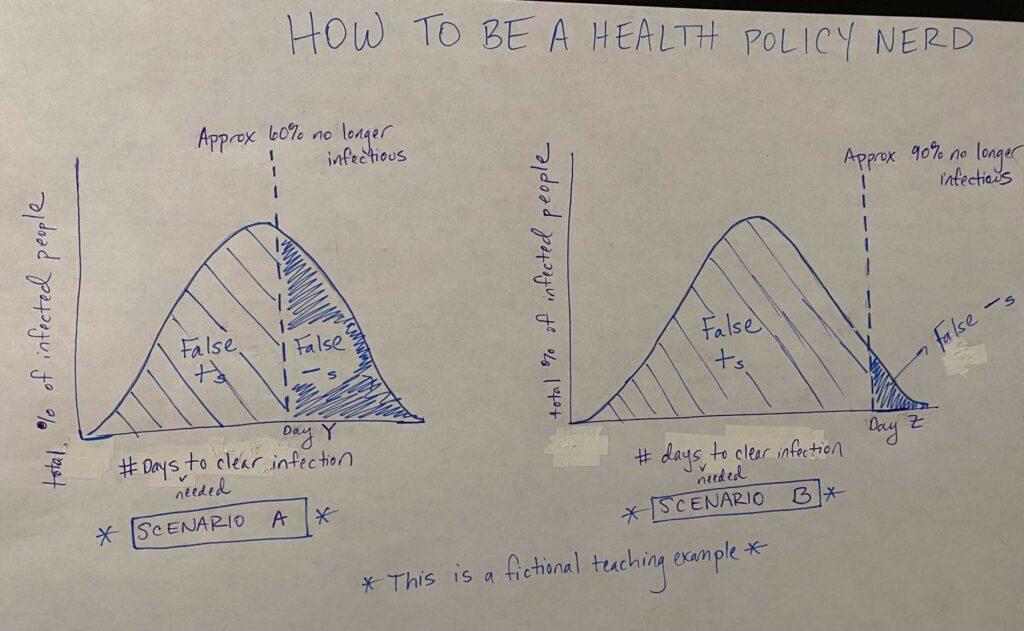A: There are no easy answers, only tough tradeoffs. Read below to learn how to stay calm and think on.
💥Think Like a Health Policy Nerd: A New Occasional Series💥
Pandemic policy chatter is a bit like an epidemic curve. A controversial health policy decision lands. It’s met with loud cheers by some and louder jeers by others. Vitriol and outrage and nastiness among warring experts rule supreme on social media. Everyone has an opinion, BIG FEELINGS, and the information environment becomes wildly chaotic and confusing. Eventually things settle down until the next controversial policy decision is made. Lather, rinse, repeat.
Case in point: The CDC recently made a series of controversial (and confusing) recommendations to cut isolation and quarantine timelines. For all of the gory details, see links below.
❓How can we keep a cool head and a sharp mind when policy controversy flares?
➡️ We can think like a Health Policy Nerd.
This post is the first in a planned occasional series. The goal: Share habits of mind to help our community calmly and wisely surf health policy controversies. This series will NOT advocate for or against specific policies. Why not? First, we hold dear the ideal of bipartisanship. Second, because WE NERDY GIRLS OFTEN DISAGREE ON POLICY ISSUES. That’s right – in addition to being scientists, we are human beings with varying political beliefs, ideologies, personal backgrounds, and raw emotional reactions to controversial topics. We love each other. We fight hard but fair about policy controversies. It’s all good.

Let’s kick off the series by explaining what, exactly, professional health policy nerds do. Weighing in on recommended isolation length for infected individuals offers a nice introduction to the tools of the trade.
1. First, policy nerds whittle down endless complexity to the core TRADE-OFF(s) at play.
Instructively, a leading (and truly riveting!) health policy podcast is named “Tradeoffs.” (Link below. Highly recommended.)
Let’s take the case of setting isolation guidelines. As shown in the simple (fictional!) visual below, people stay infectious for varying lengths of time. [Editorial note: Apologies for the humble drawing.] It’s impossible to know precisely how long any given individual remains infectious.* People and institutions need guidance about isolation timelines. Now. At the heart of the debate is how to balance false positives against false negatives.
Consider:
Fictional Scenario A: Shorter isolation interval.
⬆️ false negatives: More infectious people are mistakenly released from isolation.
Probable downside: Increased infection risk & associated ripple effects (truly awful). Probable upside: Fewer unnecessary restrictions on essential workers, caregivers, and educational + economic activity.
vs.
Fictional Scenario B: Longer isolation interval.
⬆️ false positives: More non-infectious people are mistakenly kept in isolation.
Probable downside: Non-infectious essential workers and caregivers sidelined & associated ripple effects (truly awful). Probable upside: Fewer infections, much-needed reprieve for health care workers.
The health policy nerd openly acknowledges that BOTH ARE BRUTAL. Our society has been brought to its knees. There is so much suffering. The best we can hope to do is minimize it. [Editorial note: Kindness sorely needed in all places and spaces].
Health policy 101: There are typically no easy answers, only tough tradeoffs. Task at hand: Tackle this harsh reality head-on, with a sharp mind and soft heart.
2. Next, they identify and communicate KEY CONSTRAINTS
Uncertainty about short-term versus longer-term impacts, possible unintended consequences, a lack of widespread access to tests, alarming case rates, the horribly overburdened health care workforce, a tight labor market, overstretched formal + informal caregiving networks, and pandemic fatigue (etc.) are all provided a seat at the table. None get ignored or trivialized. Again, the mandate is to tackle harsh realities head-on.
3. Then they convene and listen to COMPETING CONSTITUENCIES.
Professional policy nerds are paid to convene warring parties. They quickly garner data and opinions about the key tradeoffs from squabbling scientists. They hold space for the experiences of desperate & depleted doctors. They take the time to learn what executives from essential industries need to keep the metaphorical trains running. They listen to medically vulnerable patients and exhausted family caregivers and educators and parents. And yes, they do a pulse check on public opinion and political realities. Identifying and listening to “stakeholders” – literally, those with a major stake in the decision – is a core part of policy analysis.
It’s hard to demonize people after you’ve listened to and empathized with them. Which is why the best health policy analysts don’t make personal attacks or pass moral judgments. They honor all emotions and assume good intentions. Their default: Smart, kind-hearted people sit on both sides of a controversial policy debate. Some of these smart, kind-hearted people will prefer Scenario A in the fictional example depicted below. Others will prefer Scenario B.
4. Next step: Policy nerds apply a rigorous form of INTELLECTUAL HUMILITY.
A policy analyst asks herself the following: “Can I clearly and fairly articulate the best arguments of both sides?” In our example, she would force herself to communicate the best arguments for and against Scenario A. She would do the same for Scenario B. She does not pass go until the answer is yes. Then she puts her work to the test – does it pass muster with her peers, the warring parties, the relevant policymaker? This can take a variety of forms – anything from formal, written review requests when time permits to a quick set of conversations when time is tight.
In practice, developing clearly communicated pros and cons typically requires looping back and forth between steps 3 and 4.
5. It’s go-time: Policy nerds develop and present PRACTICAL PATHS FORWARD
The policy analyst’s key product is a set of PRACTICAL PATHS FORWARD for the policymaker. For example, she might offer the following two hypothetical options. (WARNING: These are educational placeholders – they are NOT proper, well-thought out policy examples! PLEASE do not treat them as such!!)
(1) Choose Scenario A and surge every resource possible to health care settings. Work hard to ramp up testing;
(2) Choose Scenario B and push out as much federal financial aid to unpaid family caregivers as possible. Work hard to ramp up testing.
The policy analyst typically limits herself to three or four options. Policymakers face the same working memory constraints as the rest of us.
The end goal: Discipline the policymaker to choose a key priority and cushion the resulting blow as much as possible.
6. Finally: Policy nerds MAKE PEACE with the decision, whatever it may be.
Policymakers are human. They are sometimes swayed by quirky stories or political winds or their own emotional stuff. They have bureaucratic red tape to navigate and careers to protect. They are also swayed by well-communicated data, appeals to the public good, and the honorable call of duty. They mostly do the best they can.
A good analyst makes peace with the policymaker’s final decision and readies herself for the next at-bat. Which is always just an inning away.
💥A final Nerdy note:
Health policy weaves epidemiology’s powerful quantitative insights into a tapestry also containing political, emotional, ideological, and managerial threads. It further draws on frameworks from economics, behavioral science, and government, among other social sciences. Its key concern is balancing health outcomes with other societal priorities, ranging from education to caregiving shortages to labor markets to public budgets…and beyond. It’s messy but meaningful work.
The best policy experts make peace with uncertainty and harsh tradeoffs. They are clear-eyed about reality. They honor people’s emotions without getting swept away by them. They are skilled in the arts of data analysis and deep listening. They cut to the chase with speed. They communicate with clarity and kindness. They assume good intentions on both sides. They are the adults in the room. (They are rarely the life of the party). Their toolkit is useful in our collective efforts to stay safe and sane. We want them on the team 😊.
Not to worry, we’ll be back soon to provide a practical breakdown of the new thicket of CDC guidelines. In the meantime, we send our care and concern and shared hopes for calmer waters ahead.
Love,
Your Nerdy Girls
Note:
* Even under conditions with widespread access to the best available tests, it’s impossible to perfectly sort the infectious from the non-infectious. Diagnostic technology is wonderful but it isn’t magic.
Punch line: The key tradeoff between false +s and false –s generalizes beyond the fictionalized set-up depicted in the image. For deeper testing dives, see our earlier posts.
References:


